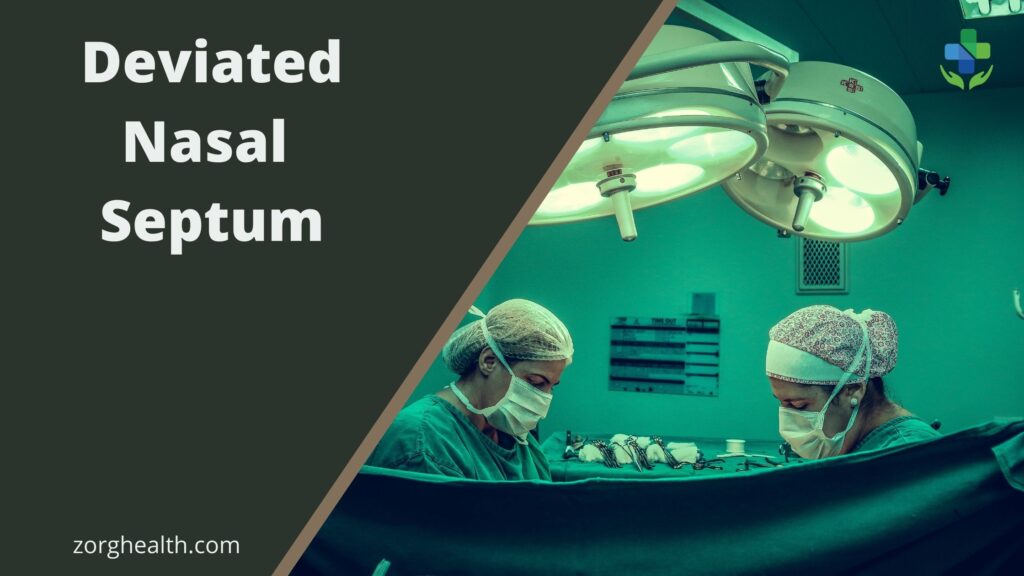What is deviated nasal septum?
The nasal septum is the midline bony and cartilaginous plate inside your nose dividing your nose into two halves right and left. When this partition is “off-centered” then it’s called a Deviated nasal septum (DNS). Almost everyone has an “off-line” septum but the majority have a lesser degree which mostly goes unnoticed. Surgery for deviated nasal septum is needed when one has severe degrees of deviation compromising one or both nasal passages. Here in this article, we talk about the causes, symptoms of the deviated nasal septum and Surgery for deviated nasal septum.

What causes deviated nasal septum
Deviated nasal septum can be due to-
- Development- with the development of other facial structures, the nasal septum also grows. But this growth can be “off-line” compromising one or both airways.
- Childbirth trauma- trauma during vaginal birth can lead to misalignment of nasal bones and further faulty or “off-line” development.
- After injury- nasal fractures are the most common among facial injuries worldwide. Example- road traffic accidents, fights, sports injuries, falls, etc.
- Secondary to mass or polyps in the nose- any structural growth (tumor or polyp) can deviate the nasal septum due to pressure.
Symptoms of the deviated nasal septum(DNS)?
If this septum is not in the midline, it will obstruct one or both sides of the nose. Deviated nasal septum (DNS) can lead to –
- Nose block
- Noisy breathing or intolerance to heavy work
- Headache
- Repeated cold or sinusitis
- Sometimes nasal bleed
- Facial pain
- Mouth breathing or snoring
- Apneic (choking) attacks at night
What to do if you have deviated nasal septum?
Minor deviation only gives a problem during cold as there is an already compromised passage. You might just need proper care during a cold if you have minor deviations. But severe deviations may irritate you with one or more of the above-mentioned symptoms with varying degrees of severity. Go to the ENT doctor if you have any of these symptoms. After examining you might be asked to get some tests like endoscopy, XRAY, or CT scan to grade the severity.
The definite treatment for symptomatic DNS is septoplasty (surgical correction of DNS). However, surgery depends on many factors like the type of deviation, age, other risk factors, profession, etc. many times it can be combined with “rhinoplasty” (reshaping of the nose) and called septorhinoplasty.
Another operation is fracture reduction, after trauma in addition to midline bone the side bones can also be fractured and deviated. In that case, your septum and side bones are straightened out with instruments.
Surgery for deviated nasal septum
Surgical correction of DNS is a painful process with the added risk of aspiration of blood that is why it’s almost always done in general or full body anesthesia. The most common procedure is called septoplasty. It can also be done in local anesthesia as well especially when deviations are minor and more anterior (front side). In general anesthesia, you don’t feel pain as you are put to sleep with the help of drugs.
if you are based out in Delhi or willing to come to Delhi you can contact Dr. Suresh Naruka (Ent Specialist at Apollo Hospital, New Delhi) and consult about deviated nasal septum surgery.
What is septoplasty?
In this, after incising the skin of the septum the deviated cartilage or bone is straightened out and if required the excess part is removed. And then the corrected septum is supported with sutures and pack inside your nose.
Rhinoplasty or septorhinoplasty- in this in addition to the “nose job” septum is also accordingly corrected and straightened out.
What happens after the deviated nasal septum surgery?
After recovering from anesthesia, you might feel some pain which is easily managed with pain killers. You will need to breathe from the mouth as both the nasal passages are packed. Most packs are removed from 48-72 hours. Slowly the operated passages heal and the airway becomes better. Sometimes and more frequently with septorhinoplasty, there can be facial swelling as well, but that settles down in 2-5 days.
What are the side effects after deviated nasal septum surgery?
The most common side effect is bleeding, as the nose is richly supplied surgery may lead to excessive bleeding. Other side effects can be –
- Perforation or hole in the septum
- Reduced smell perception
- Synechiae (fibrotic band) formation
- Numbness upper teeth or gums
- Septal bulge/swelling due to internal bleeding (hematoma)
- Failure of surgery/ persistence of the problem
How can one prevent deviated nasal septum?
There is actually nothing you can do to prevent DNS apart from protecting your nose. Helmets, seatbelts, sports gear are a few options that can lead to no or less harm from accidents and injuries.
How can you manage the symptoms of mild DNS?
As mentioned earlier minor or mild DNS can be problematic during the cold. You can use decongestant nose drops, antihistaminic tablets, and steroidal sprays for relief, but these should be taken as per medical advice.
What are the complications of deviated nasal septum?
Ignoring the symptoms of DNS might lead to future problems like-
- Sinusitis
- Obstructive sleep apnea
- Infections
- Nasal bleeding
Deviated nasal septum can easily be corrected surgically. Early correction can save you from developing its complications.
